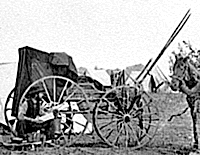The US Civil War or The War Between the States is something that has always interested me. For a brief timeline of the war click here. Those of you who are not from the states probably are less familiar with this and how many Civil War buffs are still walking around today.
Many of them spend copious amounts of time involving themselves in reenactments of battles and life as it was during that time.
Civil War Reenactment HQ offers a collection of information about this including a lists of events, units, and a beginners guide to reenactments.
The Civil War Reenactors Homepage has a lot of information as well. But what I really wanted to write about here are those old time photographs that we see from that time period. Photography was much more time consuming and difficult than it is today.
"During the Civil War, the process of taking photographs was complex andtime-consuming. Two photographers would arrive at a location. One would mix chemicals and pour them on a clean glass plate. After the chemicals were given time to evaporate, the glass plate would be sensitized by being immersed -- in darkness -- in a bath solution. Placed in a holder, the plate would then be inserted in the camera, which had been positioned and focused by the other photographer. Exposure of the plate and development of the photograph had to be completed within minutes; then the exposed plate was rushed to the darkroom wagon for developing. Each fragile glass plate had to be treated with great care after development -- a difficult task on a battlefield."
Pictured above Cold Harbor, Va. Photographer's wagon and tent Between 1860 and 1865
Aside from the difficulty in taking photos I always find it interesting to see how serious so many of the subjects of the photos were. Few if any appear to be smiling.Thanks to the Library of Congress I have a few samples to share here. This link takes you here:
The Selected Civil War Photographs Collection contains 1,118 photographs. Most of the images were made under the supervision of Mathew B. Brady, and include scenes of military personnel, preparations for battle, and battle after-effects. The collection also includes portraits of both Confederate and Union officers, and a selection of enlisted men. An additional two hundred autographed portraits of army and navy officers, politicians, and cultural figures can be seen in the Civil War photograph album, ca. 1861-65. (James Wadsworth Family Papers). The full album pages are displayed as well as the front and verso of each carte de visite, revealing studio logos, addresses, and other imprint information on the approximately twenty photographers represented in the album.
If you are not familiar with the story of President Lincoln's assassination I would recommend that you read more about it here. It is a fascinating story and a reminder that Booth was not alone.
 |
| [Washington, D.C. President Lincoln's funeral procession on Pennsylvania Avenue] |
 |
| [Washington, D.C. Hanging hooded bodies of the four conspirators; crowd departing] |
Regarding credit for all photos:Library of Congress, Prints & Photographs Division, [reproduction number, e.g., LC-B8184-3287]



No comments:
Post a Comment